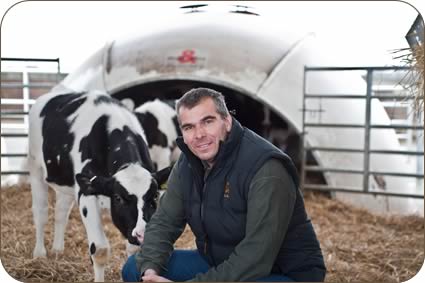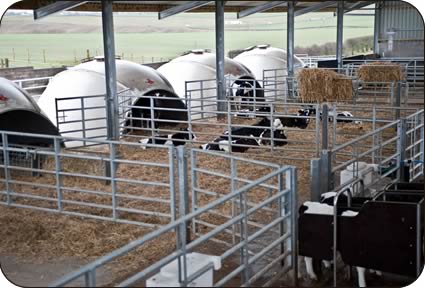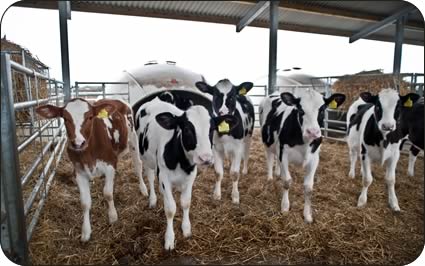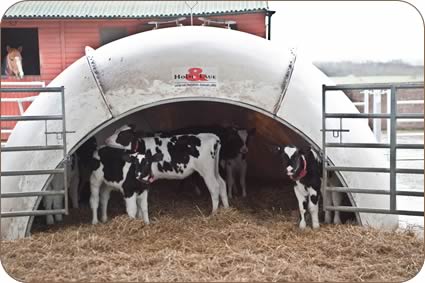Jennifer MacKenzie is an agricultural photo journalist with almost 30 year's experience. Operating from her base in Cumbria, Jennifer undertakes mainly industry-related freelance writing and photography.
Calf Igloos at Broadlea
Less is more with new dairy calf housing at Broadlea Farm, Eaglesfield,
Lockerbie.
A new calf building has been among the latest investments for Martin and Karen Wilson since they began farming at the 214 acre Broadlea Farm in 2000 where they now milk 165 commercial Holsteins.
 |
| Martin and his calves in the igloos |
However, concerned about pneumonia and calf mortality, after much consideration, Martin decided on an open sided double span building with free access from calf pens to five fibreglass igloos outside.
Not only has calf health improved massively and vaccination and treatment costs have disappeared, but the shed and igloos cost just over half the cost of a more traditional clad and insulated building. Payback on the whole investment, including labour, is likely to be around eight years.
In less than two years, the first batch of heifers reared in the new building is due to begin calving in June. Not only have the heifers stayed completely free of pneumonia with mortality down to nil, their growth has been such that heifers are being bulled earlier to calve at two years old, with bulling goals reached at 12 months of age.
 |
Now, thanks to the success of the new shed which has an automatic calf rearer, 72 heifers from the farm’s 160 youngstock are due to come into the herd, enabling the Wilsons to gradually expand herd numbers to an optimum 250 milkers.
“We have built and altered probably 90 per cent of the farm steading and five years ago we made the big mistake of converting a dutch barn with a lean-to on each side into the calf house,” said Martin, who originally came from Southwaite, in Cumbria.
“We used it for three years but we had no end of problems and the best thing we did was to knock it down. We saw the igloos made by German company Holm and Laue in an article and we were taken by the system.
“We used the igloos for the first winter without the adjoining new building which was already planned for the old building site and that winter temperatures dropped to -18 at night and were as low as -14 during the day, yet the igloos provided a microclimate for the calves and they thrived. The calves easily survived the cold but when it was wet and windy they went into the igloos for shelter,” added Martin.
 |
The new 37 metre by 15 metre building has five 25 sq metre pens which adjoin the 4.4 metre diameter igloos. At one end of the shed there are 12 calf cubicles for training and this is the only side of the building which is clad as there is no access to an igloo.
A two metre overhang at the roof eaves helps keep the worst of the rain out of the building but Martin has found that if the bedding gets wet it dries just as quickly because of the airy conditions.
There is also a dry room in the centre of the building which houses the automatic calf feeder, milk powder and calf cake and which during the last severe winter - its first - was able to be heated to prevent the machine freezing up.
The pens are created solely by gates, the only fixtures other than feeding troughs and the cubicles, which can be arranged for access for mucking out, which is done religiously when the bedding gets to 6 inches deep to reduce ammonia and coccidiosis risk, and to form a handling race within each pen.
New born calves are taken off their dams before the first milking.
With the herd testing negative for Johnes, they are fed pooled colostrum
twice a day in individual pens for the next six days before being moved
into the new shed.
They are then fed on the calf feed system for the next 58 days until they are automatically weaned.
 |
When they are first housed, each pen and igloo can accommodate up to 18 calves and as they grow the space at the feed barrier dictates how many are left in each pen. The shed can hold up to 80 calves.
At five months old they are moved into another cubicle building with an automatic scraper.
“The whole system has health and welfare benefits and with being able to have large groups of calves fed automatically it is labour saving and worker-friendly,” said Martin, who employs one full-time man.
“The system has had a 100 per cent improvement on calf health and mortality. In the last 18 months we haven’t had to treat any calf for pneumonia not have we vaccinated to prevent it.
“The biggest cost is not losing a calf to pneumonia but in the calf which recovers from it because she never performs as well. I can pick out the cows in the herd which have had pneumonia because of their general condition and inability to thrive.
“We are aiming to calve the heifers at two years old and at bulling our criteria is for the animals to weigh a minimum of 350kg and be 1m 26cm at the withers and now heifers are easily achieving this by 12 months old,” said Martin.
The new system has created great interest in the industry including the Wilsons’ milk buyer Arla who is working with Kite Consulting to share best practice for the Asda DairyLink programme.
The herd’s current production is 9,400 litres sold on a liquid milk contract. The cows are fed as one group on a semi-TMR based on home-grown fodder. The winter ration is 17kg grass silage, 15kg maize silage, 5,5kg of a 26 per cent protein blend, 4kg crimped wheat plus minerals. This year 35 acres of maize and 34 acres of wheat will be grown.
The ration is fed to 26 litres once a day at night with cows being topped up in the parlour with a 19 per cent protein concentrate to give an average protein content for the diet of 17 per cent. During the summer the cows are housed at night with access to the ration.
Martin’s focus on the herd now is not on production but on the type of cow. “We have totally capped size. Big cows are nice to look at but they don’t last. We’re looking for cows that are reduced in stature with more ‘heart’ - a bigger chest capacity - coupled with improved leg and feed which we have always concentrated on,” said Martin who is reluctant to buy in replacements.
With size in mind, more red and white Holstein bloodlines are being used and all the herd is now put to the dairy bull. Heifers have been running with a Classic Red son on an indoor woodgrain corral made from pallets and ground to the size of barley grains.
Current AI genetics used in the herd are Dutch bulls from Avoncroft - Poos Stadel Classic Red, Barendonk Trendsetter, another Classic Red son, Huybens Red Devil and Beukenhof 346 Ideal.
North American sires most recently used have been Regancrest Mr Durham Sam, first used six years ago creating a benchmark type for the herd, Go-Farm Allen Scooby Duu, Regancrest Design, Eurostar Laurens James TKO and New World Emipire, all from World Wide Sires.
Martin Wilson can be contacted on martin.wilson5@sky.com or
07779814430.

